
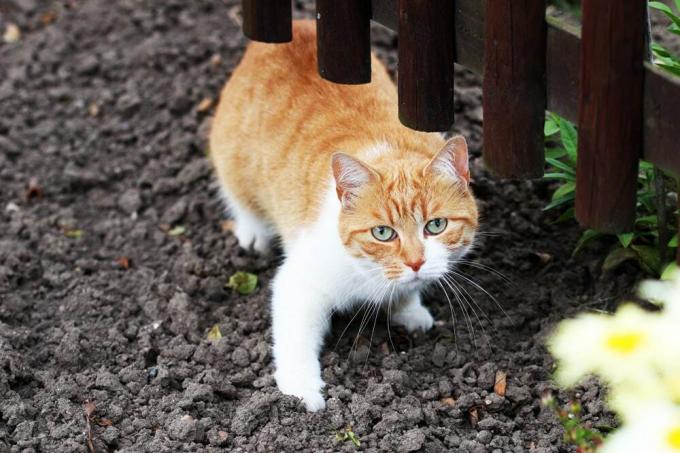
Table of contents
- characteristics of the cat
- protect beds
- Keep cats at a distance
- Clap your hands vigorously
- Splash with water
- Scents that cats don't like
- Ultrasound defense
- Optical deterrents
- Own a cat
Some count purring house cats among their housemates, while others get extremely upset about strange cats visiting the garden. To some extent for good reason, as cats churn up the earth, loll on sprouting seeds and prey on songbirds. However, there are definitely options that cat lovers and garden owners alike can easily cope with.
characteristics of the cat
Of all our pets, the cat is our number one pet. She is easy to care for, entertains herself when no one has time for her, and doesn't need to be taken for a walk. Outdoor cats find their way out on their own, unfortunately sometimes to the chagrin of people in the vicinity. Cats have a strong urge to explore. Curiosity is in their nature. Ultimately, cats are still predators with very fine hunting instincts. Prey could be lurking anywhere, so the environment is always inspected very closely. The typical characteristics of a cat can be described as follows:
- curious
- clever
- stubborn
- independent
- sovereign
- moody
- playful
- cuddly
- hydrophobic
- noise sensitive
If you know a cat's character traits, you can deal with them better and know which measures work and which don't. However, there are very temperamental and, in contrast, rather shy, reserved individuals. All cats have one thing in common: They love freedom.
Tip:
According to one judgement, the prescribed tolerance of free-roaming cats has reached its limit with two animals. Since the definition of the legal situation is quite imprecise, it depends on the individual case why Experts first advise talking to the neighbors who have three free-roaming cats and more holds.
protect beds
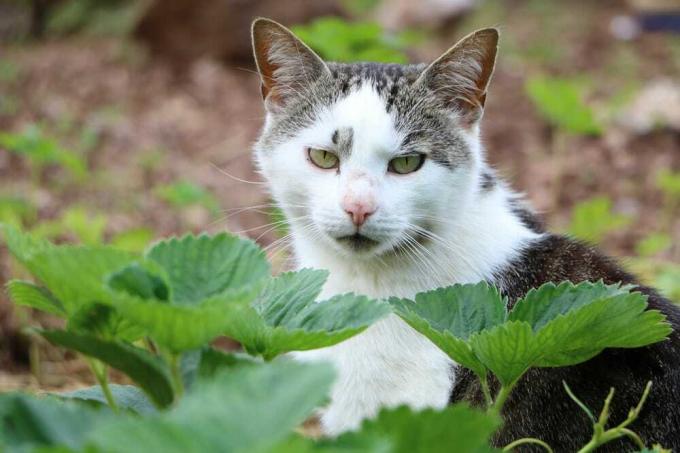
In the garden, freshly laid beds are particularly popular because they can be used as a litter box. Cats bury their "business". Full of devotion, a hollow is dug, a seat is taken over it and, after the work is done, the hole and its contents are shoveled back in. This behavior usually applies to urination as well, unless it's a scent-marking hangover.
The drier and looser the soil, the more popular it is with kitties. Unfortunately, all the more unpleasant for the hobby gardener who has previously spread seeds or planted onions. After such a cat visit, the plants are guaranteed to no longer grow in a straight line. Possibly nothing works at all. If it specifically affects individual beds, the following measures protect against scratching damage:
- Keep soil moist by watering (dry places are preferred)
- Spread out garden fleece
- Lay the wire grate on the bed
- Distribute shrub cuttings between the sown rows
- mulch beets
As soon as the seed sprout from the ground and has reached a certain height, the bed loses its attractiveness. Cats fixate on an acceptable open space. The space between rows, which is usually only 15-20 cm, does not meet their requirements. Bark mulch has proven itself between ornamental plants. Cats prefer fine-grained material. Pieces of bark used to cover beds and borders are definitely too big for them.
Keep cats at a distance
The defense against cats probably affects not only beds, but the entire garden. If you have little sympathy for cats, you probably don't want to be bothered by neighbor cats in general. Especially since some kitties are not only limited to the outside area. Some velvet paws even walk unabashedly into the house or make themselves comfortable on the garden furniture. Especially when they are moulting, they leave traces in the form of hair on loungers, benches and seats.
If you sit on a chair where a cat was previously lying, you will get cat hair on your pants. There may even be an animal hair allergy, which manifests itself in coughing and sneezing, reddened eyes or skin reactions. In these cases, it is understandable that cats are among the unwelcome guests. The following methods drive away cats:
Clap your hands vigorously
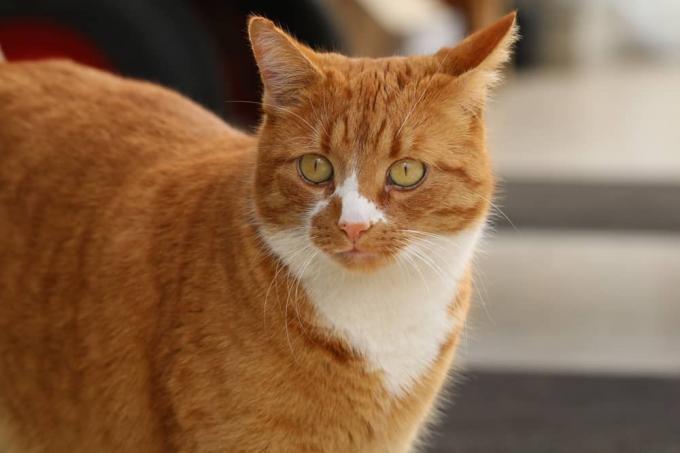
Kitties cannot be trained, at least not in the way dogs are known. The free spirit of these animals knows neither rules nor submission. But that is exactly what fascinates many about these creatures. Despite very good hearing, cats pay little or no attention to a "no" or a request to leave. Completely unexpected acoustic events are required to get them to leave the garden. A cat does not react to known noises that are classified as harmless. Spontaneously clapping hands is a good idea, which the animal doesn't expect. The alarm bells are immediately ringing. Kitties respond to scary situations with attack or flight. With no prospect of a successful offensive, the cat quickly flees. Instead of clapping your hands, you can also make these loud noises:
- shrill sound of a referee's whistle
- Beat a wooden spoon on a saucepan
- Make the balloon squeak by letting the air out
- rattle with a ratchet
Cats have very good learning and memory skills. Places that evoke bad experiences will be avoided in the future. Unfortunately, it's not quite that simple. Because a kitty doesn't give up too quickly. The cat only backs down in the long run if it has endured several shocking moments.
Splash with water
Water is essential for house cats to drink. But every further contact with the wet element is scrupulously avoided. There is even a downright aversion to water. Scientists attribute this to the loss of body odor when bathing. Despite this, cleanliness is a top priority, with grooming being carried out exclusively using the tongue. Antipathy towards water is great for scaring cats away. Are suitable:
- water gun
- water hose
- Water jet animal repeller
Ideally, a sprayer should always be available so that it can be used immediately if necessary. Waterjet repellers are on constant ambush. As soon as the electronic sensor detects movement, the device reacts with a jet of water in the respective direction, usually with an adjustable range of up to 10 m. The connection is made via a water hose. The line can remain turned on, because water is only released when the detector receives pulses. Experience has shown that even with the water method, a single application does not immediately lead to the cat staying away permanently. So don't lose patience. Splashed with water several times, soon there will be no more interest in your garden.
Scents that cats don't like

A cat's sense of smell cannot be compared to that of a dog, but cats have more than three times as many olfactory cells as humans. As a result, smells often determine behavior. The highly developed noses react sensitively to various scents. Cats usually give a wide berth to the following intensively smelling plants and substances:
- piss off plant
- Anti-cat spray
- lemon
- Vinegar
- pepper
- coffee grounds
The smell method does not work equally well for all cats. Furthermore, the respective efficient radius is only up to 5 m. In order to create a thorough effect with the piss-you-plant, for example, it is advisable to use several specimens in larger outdoor areas. As with the anti-cat spray, which is mainly suitable for spraying paths and squares, it is the essential oils of the plant that make cats discourage them from staying around.
The acids in lemon juice and vinegar irritate the mucous membranes. Dropped onto rags, the strong smell forces cats to leave the place. As soon as cats sniff a foreign territory, finely ground pepper induces a sneeze reflex. Dried coffee grounds also give off an odor that cats hate. The scattered powder also sticks to the paws. At the latest the next time you clean, the unpleasant aroma hits you badly.
Ultrasound defense
Sticked into the ground with a stick, a motion detector-controlled cat deterrent, usually based on infrared sensors, generates an alarm sound as soon as a cat walks by. The special advantage: the tones are in a frequency that people cannot perceive or only perceive minimally. However, the cat's good hearing catches the noises, classifies them as horrible and repulsive, so that the animal quickly flees. Ultrasonic cat deterrent devices are operated either with batteries or with the help of a solar module.
Optical deterrents
A method common to crows can be applied to cats. Reflecting objects moving in the wind induce fear in corvids and other intruders. To turn your yard into a spooky place for cats, you can choose between:
- aluminum strips
- old and defective CDs
- shiny pieces of metal
- Mirror

You can distribute the reflective elements in trees or shrubs or hang them on a taut string. It is important that the free flow of air is maintained so that the reflection varies constantly. Aluminum strips rustle in the wind, and when other objects are lined up in such a way that they bump into each other with every breeze, there is also a terrifying background noise.
Tip:
Did you know that cats are considered lucky in China? Perhaps this perspective will help reduce resentment towards unexpected cat visits.
Own a cat
Finally, a method that is only suitable for a part of all affected garden owners, because it requires a proper affection for cats. Getting your own cat has proven to be very effective in blocking the way into the garden for strange cats. Both male and female animals keep their territory clean. The four-legged friends regard the house, yard and adjacent green area as their personal territory. Cats are mostly individualists who do not tolerate competition. If a stranger invades the familiar zone, heated debates ensue, if necessary using claws and teeth.
 garden editorial
garden editorial I write about everything that interests me in my garden.
Learn more about animal defense

Bird repellent: with these means you drive birds away from the balcony
Pigeons, sparrows and many other bird species often choose a balcony as a resting or even nesting place in the city. However, to ensure that your own balcony is spared bird droppings in particular, there are various measures that can be used effectively here without harming the animals.

Scare away foxes from the garden and keep them away
Whether in the city or in the country - more and more hobby gardeners meet foxes in their own green kingdom and ask themselves how they can scare them away. We have summarized which measures are best suited for this in this article!
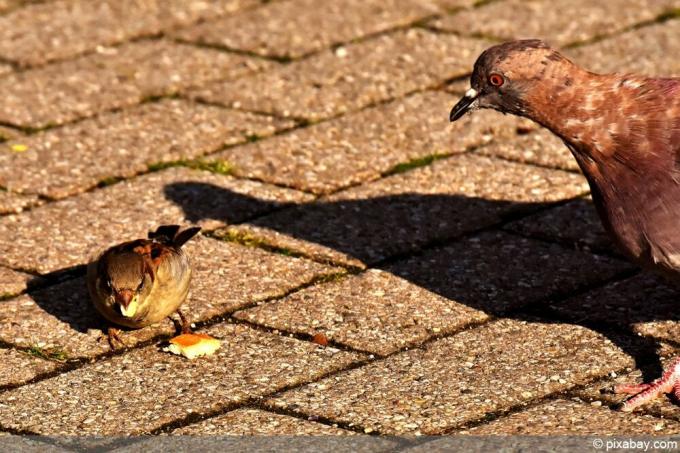
Prevent birds under roof tiles and roof overhang
If birds settle under the roof tiles and the roof overhang, this can lead to damage to the building fabric. The droppings cause unsightly dirt, and breeding songbirds make a lot of noise. Various countermeasures have proven effective in preventing unwanted colonization.

Remove sparrow nest under the roof
Where people live, sparrows are not far either. With a few exceptions, this applies all over the world. Sparrows are cultural followers, they have adapted to the way of life of humans. What to do if sparrows breed under the house roof?
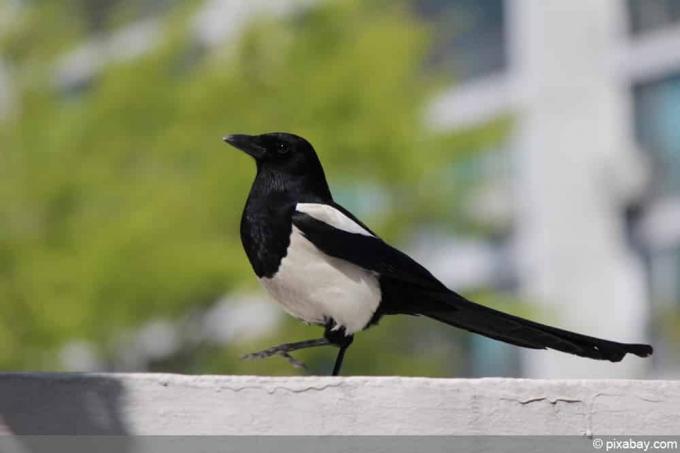
Recognizing magpie droppings | Magpie droppings with picture
Bird droppings on the terrace or on the light wall of the house are a nuisance. What culprit is behind this? Was it the magpies? We'll show you how to spot magpie droppings and how to get rid of them.

Recognize badger droppings in the garden: 6 characteristics
Have you ever seen a badger in the wild? The animals with the black stripes on their faces are common in German forests. She is increasingly drawn to the city. Their legacies are annoying. How can badger droppings be identified?
